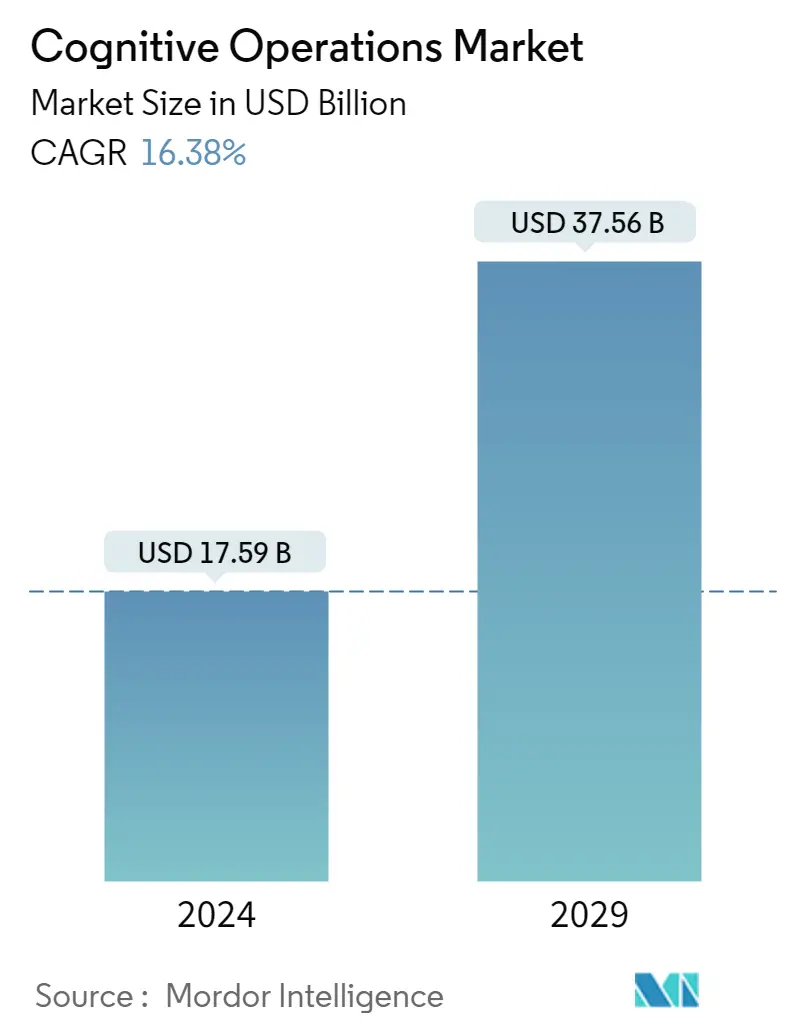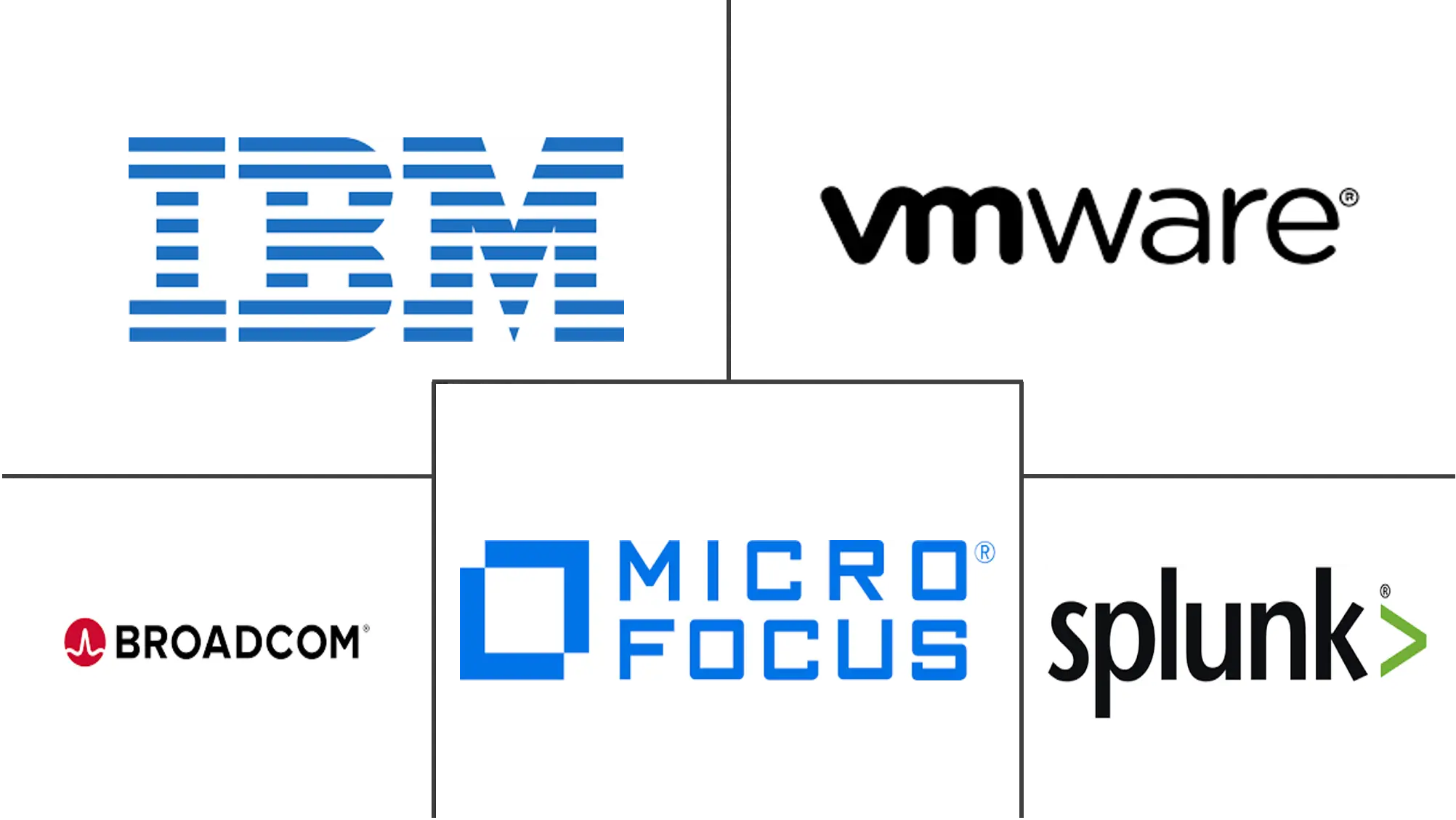Market Size of Cognitive Operations Industry

| Study Period | 2019 - 2029 |
| Market Size (2024) | USD 17.59 Billion |
| Market Size (2029) | USD 37.56 Billion |
| CAGR (2024 - 2029) | 16.38 % |
| Fastest Growing Market | Asia Pacific |
| Largest Market | North America |
| Market Concentration | Medium |
Major Players
*Disclaimer: Major Players sorted in no particular order |
Cognitive Operations Market Analysis
The Cognitive Operations Market size is estimated at USD 17.59 billion in 2024, and is expected to reach USD 37.56 billion by 2029, growing at a CAGR of 16.38% during the forecast period (2024-2029).
- Organizations are moving their essential business apps to the cloud because of its scalability, lower cost, and ease of deployment. Predictive analytics skills can be swiftly integrated into a variety of corporate applications with the use of cloud-based technologies. These advantages likely increase demand for cloud-based cognitive operations solutions.
- As the technology reaches the next level, Robotic Process Automation (RPA) integrates with Cognitive Operations. Cognitive RPA is utilized to produce higher productivity, scalability, and enhanced efficiency since it can use Natural Language Processing (NLP), Optical Character Recognition (OCR), and Machine Learning to make sense of masses of data. Integrating cognitive processes with RPA helps Chatbots better manage complicated, real-time requests from customers and employees by using company data and navigating legacy enterprise systems.
- The Covid-19 outbreak brought a significant transformation in the lives of communities and businesses. Customer shopping behavior and demand changes urged companies to adopt automated processes to remain competitive. By using Cognitive Computing in the e-commerce industry, companies can monitor the shopping behavior of the buyers, like their brand preference, online purchase frequency, navigation pattern in the store, and so on. Similarly, based on the industry, cognitive solutions can be customized and help businesses expand and generate revenue.
- The initial investment in cognitive operations is high. It takes a long time and requires skilled development teams to create the software for these systems. The systems need extensive, in-depth training with large data sets to understand specific jobs and procedures. Due to these factors, the companies are not easily convinced to adopt these cognitive operations, and thus, there is slow growth in the market.
Cognitive Operations Industry Segmentation
In complex circumstances where the solutions may be unpredictable, cognitive operations use computerized models to imitate the human reasoning process. It concerns how quickly and efficiently problem solutions can be extracted from data and implemented. Cognitive operations use AI-based optimization techniques to automate the planning, control, and optimize production and supply chain activities. By adopting cognitive operation solutions, significant savings can be made on essential resources, including energy, plant capacities, and human resources.
The Cognitive Operations Market is segmented by component (solutions and services), deployment mode (cloud and on-Premises), enterprise size (large enterprises and small and medium-sized enterprises), application (IT operations analytics, application performance management, network analytics, security analytics, infrastructure management, and other applications), industry vertical (BFSI, healthcare & life sciences, IT & Telecom, retail & e-commerce, and other industry verticals), and geography (North America, Europe, Asia-Pacific, and rest of the world). The market sizes and forecasts are provided in value (USD).
| By Component | |
| Solutions | |
| Services |
| By Deployment Mode | |
| Cloud | |
| On-Premises |
| By Enterprise Size | |
| Large Enterprises | |
| Small and Medium-Sized Enterprises |
| By Application** | |
| IT Operations Analytics | |
| Application Performance Management | |
| Network Analytics | |
| Security Analytics | |
| Infrastructure Management | |
| Other Applications |
| By Industry Vertical | |
| BFSI | |
| Healthcare & Life Sciences | |
| IT & Telecom | |
| Retail & E-commerce | |
| Other Industry Verticals |
| Geography | |
| North America | |
| Europe | |
| Asia-Pacific | |
| Rest of the World |
Cognitive Operations Market Size Summary
The Cognitive Operations Market is experiencing significant growth, driven by the increasing adoption of cloud-based technologies and the integration of Robotic Process Automation (RPA) with cognitive processes. These advancements enable organizations to enhance productivity, scalability, and efficiency by leveraging Natural Language Processing, Optical Character Recognition, and Machine Learning. The shift towards cloud solutions is fueled by their scalability, cost-effectiveness, and ease of deployment, which are crucial for businesses looking to streamline operations and improve customer interactions. Despite the high initial investment and the need for skilled development teams, the market is poised for expansion as companies recognize the value of cognitive solutions in automating complex processes and gaining insights from vast data sets.
The telecommunications and IT sectors are particularly benefiting from cognitive operations, with companies like Jio Haptik and Tata Consultancy Services leading the way in enhancing customer experiences and operational efficiencies. The Asia-Pacific region is emerging as a fast-growing market due to increased technology spending and the demand for affordable data management solutions among SMEs. Cognitive operations are also playing a vital role in smart manufacturing and digitization, helping businesses maintain quality and improve supply chain productivity. As competition remains moderate, there is substantial potential for growth, with major players like IBM, VMware, and Broadcom continuously innovating to offer AI-integrated solutions that drive cost savings and improve business processes.
Cognitive Operations Market Size - Table of Contents
-
1. MARKET DYNAMICS
-
1.1 Market Overview
-
1.2 Market Drivers
-
1.2.1 Growing Focus Toward Selection of Cloud-Based Cognitive IT Operations Solutions
-
1.2.2 Rising Demand for Monitoring the Complex IT Environment
-
-
1.3 Market Restraints
-
1.3.1 Integration of Cognitive Operations Capabilities With the Present Systems
-
1.3.2 Dearth of Skills and Expertise
-
-
1.4 Industry Attractiveness - Porter's Five Forces Analysis
-
1.4.1 Bargaining Power of Suppliers
-
1.4.2 Bargaining Power of Buyers
-
1.4.3 Threat of New Entrants
-
1.4.4 Threat of Substitutes
-
1.4.5 Intensity of Competitive Rivalry
-
-
1.5 Assessment of Impact of Covid-19 on the Industry
-
-
2. MARKET SEGMENTATION
-
2.1 By Component
-
2.1.1 Solutions
-
2.1.2 Services
-
-
2.2 By Deployment Mode
-
2.2.1 Cloud
-
2.2.2 On-Premises
-
-
2.3 By Enterprise Size
-
2.3.1 Large Enterprises
-
2.3.2 Small and Medium-Sized Enterprises
-
-
2.4 By Application**
-
2.4.1 IT Operations Analytics
-
2.4.2 Application Performance Management
-
2.4.3 Network Analytics
-
2.4.4 Security Analytics
-
2.4.5 Infrastructure Management
-
2.4.6 Other Applications
-
-
2.5 By Industry Vertical
-
2.5.1 BFSI
-
2.5.2 Healthcare & Life Sciences
-
2.5.3 IT & Telecom
-
2.5.4 Retail & E-commerce
-
2.5.5 Other Industry Verticals
-
-
2.6 Geography
-
2.6.1 North America
-
2.6.2 Europe
-
2.6.3 Asia-Pacific
-
2.6.4 Rest of the World
-
-
Cognitive Operations Market Size FAQs
How big is the Cognitive Operations Market?
The Cognitive Operations Market size is expected to reach USD 17.59 billion in 2024 and grow at a CAGR of 16.38% to reach USD 37.56 billion by 2029.
What is the current Cognitive Operations Market size?
In 2024, the Cognitive Operations Market size is expected to reach USD 17.59 billion.

